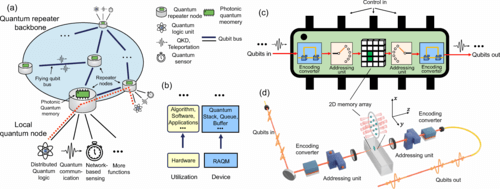Researchers from Tsinghua University and the Hefei National Laboratory in China have developed a photonic quantum memory with a capacity of 72 qubit cells, a significant advancement in quantum computing and networking. The memory, which has a coherence time above 0.5 ms, can perform 1000 consecutive operations in a random access way. This development is a crucial step towards the realization of quantum repeaters and large-scale quantum networks. However, the challenge remains in integrating the various elements of quantum memory into a single setup and making them compatible with each other.
What is a Photonic Quantum Memory and Why is it Important?
Photonic quantum memory is a fundamental component of quantum information technology, playing a crucial role in quantum computing, communication, and networking. In a quantum network based on the quantum repeater architecture, photonic quantum memory serves as the local quantum nodes that connect the communication channels, providing a key building block for these networks. For future applications in large-scale quantum computing and networking, it is desirable for the quantum memory to be versatile, supporting application-oriented operations and fitting for tasks in different scenarios.
Significant progress has been made in the realization of various quantum memories. Photonic quantum memory with long coherence time has been achieved based on atomic or spin ensembles, single atoms or ions, and single vacancy centers. To scale up the capacity of quantum memory and boost the performance of a quantum repeater, multiplexed quantum memory has been proposed and implemented via spatial modes, temporal modes, orbital angular momentum modes, wave vector directions, and other dimensions.
In the multiplexed quantum repeater protocol, a quantum memory capable of reading out the stored qubits on demand is an indispensable ingredient to achieve the full-scale acceleration in entangling rate. Random access quantum memories (RAQMs) developed recently are perfectly suitable for this task. To achieve a reasonable entangling rate over a metropolitan size of 100 km via the quantum repeater protocol, one has to combine long coherence time, large memory capacity, and high-fidelity operations all together. Although there are demonstrations for each individual technique, how to make them compatible with each other and integrate all these elements into a single quantum memory setup remains a challenging goal in experiment.
What is the New Development in Photonic Quantum Memory?
In a recent work, a photonic quantum memory with a capacity of 72 qubit cells, the size of a state-of-the-art quantum processor, was realized. The memory has a coherence time above 0.5 ms for almost all cells, corresponding to the transmission time in a 100 km fiber, and 1000 consecutive operations in a random access way, sufficient to generate any of the 72^10104 output sequences for a 72-qubit input. This is two orders of magnitude larger than the previous record.
The researchers further demonstrated quantum queue, stack, and buffer, which are the quantum counterparts of the corresponding widely used classical memory devices. As an example of applications, they demonstrated the storage and reshuffle of four entangled photonic pairs with probabilistic arrival time and arbitrary release order for the first time. This can find applications in several scenarios of a quantum network, including entanglement generation, connection, and routing.
How is the Photonic Quantum Memory Constructed?
The multipurpose quantum memory consists of a two-dimensional quantum memory array, two addressing units, and two qubit encoding converters. The 2D quantum memory array is based on a macroscopic 87Rb atomic cloud divided into 144 pieces spatially, and each of the 144 microscopic ensembles represents a quantum memory. Here, different memory cells are different parts of a single atomic cloud, and these 144 cells are not loaded into optical trap arrays, which is different from the tweezer array experiments.
Three pairs of crossed acoustic optical deflectors (AODs) act as addressing units and are exploited to direct the input or output photons to or from any of the 144 memory cells. The qubit encoding converters are used to convert the polarization qubits of the input photons into spin-wave qubits of the atomic ensembles and vice versa.
What are the Implications of this Development?
The photonic quantum memory implemented in this work, which is scalable, long-lived, fully controllable, and combines unprecedented versatility, provides key enabling ingredients for the implementation of quantum repeaters and large-scale quantum networks. This realization of a multipurpose programmable quantum memory constitutes a key enabling building block for future large-scale, fully functional quantum networks.
The ability to store and reshuffle entangled photonic pairs with probabilistic arrival time and arbitrary release order is an essential requirement for the realization of quantum repeaters and efficient routing in quantum networks. This development brings us a step closer to the realization of these technologies.
Who are the Researchers Behind this Development?
The research was conducted by a team from the Center for Quantum Information Institute for Interdisciplinary Information Sciences at Tsinghua University and the Hefei National Laboratory in the People’s Republic of China. The team includes Sheng Zhang, Jixuan Shi, Zhaibin Cui, Ye Wang, Yukai Wu, Luming Duan, and Yunfei Pu. Their work was received in December 2023, accepted in February 2024, and published in April 2024.
What is the Future of Photonic Quantum Memory?
The future of photonic quantum memory is promising, with the potential to revolutionize quantum computing and networking. The development of a high-performance quantum memory that can process a large stream of flying qubits and fulfill the requirements of multiple core functions in a quantum network is a significant step forward. However, there is still much work to be done to fully realize the potential of this technology. The challenge lies in integrating the various elements of quantum memory into a single setup and making them compatible with each other. With continued research and development, we can expect to see further advancements in this field.
Publication details: “Realization of a Programmable Multipurpose Photonic Quantum Memory with Over-Thousand Qubit Manipulations”
Publication Date: 2024-04-25
Authors: Sheng Zhang, Jianmin Shi, Zhengjun Cui, Ye Wang, et al.
Source: Physical review. X
DOI: https://doi.org/10.1103/physrevx.14.021018

